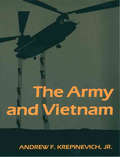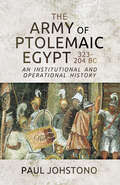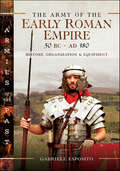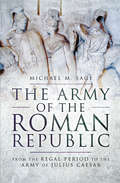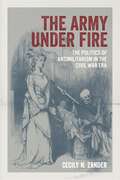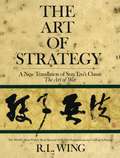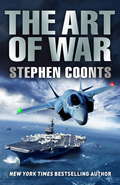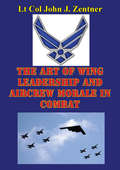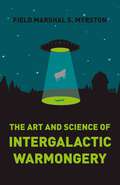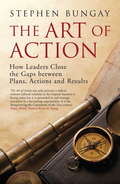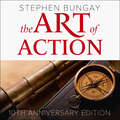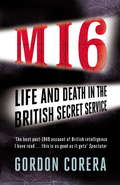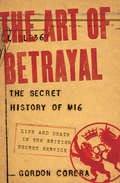- Table View
- List View
The Army Doc's Secret Wife
by Charlotte HawkesFalling for her husband? Theirs was a marriage of convenience, born out of desperate circumstances, but Thea can't forget the wedding night she spent in Ben Abrams's arms! Only, by dawn it was all over and her army-doctor husband had shipped out-out of the country and her life! Now Ben is badly wounded, and Thea must nurse him back to health. Having lost her heart to her reluctant husband once, she fears getting close to him again. Dare she hope that this time Ben will choose his desire for her over duty?
The Army and Democracy
by Aqil ShahSince Pakistan gained independence in 1947, only once has an elected government completed its tenure and peacefully transferred power to another elected government. In sharp contrast to neighboring India, the Muslim nation has been ruled by its military for over three decades. Even when they were not directly in control of the government, the armed forces maintained a firm grip on national politics. How the military became Pakistan's foremost power elite and what its unchecked authority means for the future of this nuclear-armed nation are among the crucial questions Aqil Shah takes up in The Army and Democracy. Pakistan's and India's armies inherited their organization, training, and doctrines from their British predecessor, along with an ethic that regarded politics as outside the military domain. But Pakistan's weak national solidarity, exacerbated by a mentality that saw war with India looming around every corner, empowered the military to take national security and ultimately government into its own hands. As the military's habit of disrupting the natural course of politics gained strength over time, it arrested the development of democratic institutions. Based on archival materials, internal military documents, and over 100 interviews with politicians, civil servants, and Pakistani officers, including four service chiefs and three heads of the clandestine Inter-Services Intelligence, The Army and Democracy provides insight into the military's contentious relationship with Pakistan's civilian government. Shah identifies steps for reforming Pakistan's armed forces and reducing its interference in politics, and sees lessons for fragile democracies striving to bring the military under civilian control.
The Army and Vietnam
by Andrew F. Krepinevich Jr.Many senior army officials still claim that if they had been given enough soldiers and weapons, the United States could have won the war in Vietnam. In this probing analysis of U.S. military policy in Vietnam, career army officer and strategist Andrew F. Krepinevich, Jr., argues that precisely because of this mindset the war was lost before it was fought.The army assumed that it could transplant to Indochina the operational methods that had been successful in the European battle theaters of World War II, an approach that proved ill-suited to the way the Vietnamese Communist forces fought. Theirs was a war of insurgency, and counterinsurgency, Krepinevich contends, requires light infantry formations, firepower restraint, and the resolution of political and social problems within the nation. To the very end, top military commanders refused to recognize this.Krepinevich documents the deep division not only between the American military and civilian leaders over the very nature of the war, but also within the U.S. Army itself. Through extensive research in declassified material and interviews with officers and men with battlefield experience, he shows that those engaged in the combat understood early on that they were involved in a different kind of conflict. Their reports and urgings were discounted by the generals, who pressed on with a conventional war that brought devastation but little success.A thorough analysis of the U.S. Army's role in the Vietnam War, The Army and Vietnam demonstrates with chilling persuasiveness the ways in which the army was unprepared to fight—lessons applicable to today's wars in Afghanistan and Iraq.
The Army in the Roman Revolution
by Arthur KeaveneyThe Roman Revolution is one of the most momentous periods of change in history, in which an imperial but quasidemocratic power changed into an autocracy. This book studies the way the Roman army changed in the last eighty years of the Republic, so that an army of imperial conquest became transformed into a set of rival personal armies under the control of the triumvirs. It emphasizes the development of what has often been regarded as a static monolithic institution, and its centrality to political change.
The Army of Northern Virginia
by Michael Youens Philip KatcherOn June 27, 1862, with the American Civil War already a year old, General Robert E. Lee assumed personal command of troops engaged in driving the Federal Army of the Potomac out of Richmond - troops which would henceforth be known as The Army of Northern Virginia. Philip Katcher explores in absorbing detail all aspects of the army, including infantry, cavalry, artillery, technical and medical corps, paying particular attention to equipment, weapons and uniforms. Contemporary and museum photographs, together with the author's expert text, combine to paint a vivid and accurate picture of what life was like for the average confederate soldier.
The Army of Ptolemaic Egypt 323–204 BC: An Institutional and Operational History
by Paul JohstonoA study reconstructed through a wide range of ancient sources, from histories to documentary papyri and inscriptions to archaeological finds.The Ptolemaic Dynasty ruled Egypt and much of the eastern Mediterranean basin for nearly 300 years. As a Macedonian dynasty, they derived much of their legitimacy from military activity. As an Egyptian dynasty, they derived much of their real wealth and power from maintaining a secure hold on their new homeland. As lords of a far-flung empire, they maintained much of their authority through garrisons and the threat of military action. To achieve this they devoted much of their activity to the development and maintenance of a large army and navy.This work focuses on the period of the first four Ptolemies, from the acquisition of Egypt after the death of Alexander the Great to the great battle of Raphia more than a century later. It offers a study of the Ptolemaic army as an institution, and of its military operations, both reconstructed through a wide range of ancient sources, from histories to documentary papyri and inscriptions to archaeological finds. It examines the reasons for Ptolemaic successes and failures, the causes and nature of military change and reform, and the particular details of the Ptolemaic army's soldier classes, unit organization, equipment, tactics, and the Ptolemaic state’s strategy to compile a military history of the golden age of one of the classical world's significant forces.
The Army of the Early Roman Empire 30 BC–AD 180: History, Organization & Equipment
by Gabriele EspositoThe legionary soldier of the early Empire period, with his distinctive segmented armor, is one of the images most closely associated by popular imagination with ancient Rome. Such soldiers conquered most of Britain, suffered and avenged the terrible disaster of the Teutoburg Forest and vanquished the fearsome Dacians across the Danube, a feat immortalized on Trajan’s Column, as well as fighting many other tribes. In the East they overcame the Great Jewish Revolt and repeatedly contended with mixed success against the powerful Parthians. This was the army that enforced the so-called Pax Romana at the point of a gladius and maintained the greatest empire the world had yet seen. Of course, such troops were also employed to bloody effect in the many civil wars such as those of AD69, ‘the Year of the Four of the Emperors’. Gabriele Esposito describes the tactics, organization and equipment of the Roman army at the height of its powers, considered by many to be the most efficient and powerful fighting force of the ancient world. He gives an overview of the most significant campaigns and considers in detail not only the iconic legionaries but also the various auxiliary units, including cavalry. His clear, accessible text is supported by dozens of color photos of replica weapons, armor and other kit in use.
The Army of the Roman Republic: From the Regal Period to the Army of Julius Caesar
by Michael SageFrom the moment its last king was expelled (traditionally in 753) the Roman republic had to fight for its very survival. Centuries of almost continuous warfare saw Romes armies evolve in response to a wide variety of threats which were met with mixed fortunes though always with ultimate success. As defence of the homeland turned to territorial expansion, Roman forces also had to adapt to sustained campaigns in varied terrain and climates, not to mention the changes in the Roman republic itself. Michael Sage traces the development of the republics army from its foundation (having first set the context of their regal antecedents), down to the time of its most famous leader, Julius Caesar. The transition from clan-based forces, through the Servian levy and the development of the manipular and cohortal legion is examined along with the associated weapons, tactics and operational capabilities. We see how the legions shaped up against the challenges of successive enemies from the Celts and Samnites, the Carthaginians and the hitherto-dominant Hellenistic armies based on the Macedonian-style pike phalanx.
The Army that Never Was: George S. Patton and the Deception of Operation Fortitude
by Taylor DowningThe full, dramatic story behind Operation Fortitude—the biggest subterfuge of World War II—and the plan to mislead the Germans into thinking that the invasion of Europe would come at Pas-de-Calais.On May 29th, 1944, General George S. Patton gave a speech in the southeast of England to the men of the U.S. Army where he spoke of the American desire to win and of how losing was hateful to Americans. As he rose to his crescendo, he said how much he "pitied those sons of bitches we are going up against—by God, I do.&” On that same day, General Omar Bradley gave a calmer speech in Somerset, England, to the men under his command about how much rested on the upcoming invasion of northern France and how vital their role was in achieving victory. Apart from the very different tones of the speeches reflecting the opposite character of the two army commanders, there was another big difference. Bradley was speaking to men who in a little over a week would be splashing ashore on the beaches of Normandy. Patton was addressing an army that didn't exist. The Army That Never Was tells the story of the biggest deception operation of World War II: the plan to mislead the Germans into thinking that the invasion of Europe would come at Pas-de-Calais instead of Normandy—by inventing an entirely fake army unit during Operation Fortitude. Full of fascinating characters from the American, British, and German forces, this compelling and propulsive narrative explores one of the most remarkable stories of World War II.
The Army under Fire: The Politics of Antimilitarism in the Civil War Era (Conflicting Worlds: New Dimensions of the American Civil War)
by Dr. Cecily N. ZanderCecily N. Zander’s The Army under Fire is a pathbreaking study focusing on the fierce political debates over the size and use of military forces in the United States during the Civil War era. It examines how prominent political figures interacted with the professional army and how those same leaders misunderstood the value of regular soldiers fighting to reunify the fractured nation.
The Arsenal of Democracy: FDR, Detroit, and an Epic Quest to Arm an America at War
by A. J. BaimeA New York Times BestsellerA dramatic, intimate narrative of how Ford Motor Company went from making automobiles to producing the airplanes that would mean the difference between winning and losing World War II. In 1941, as Hitler's threat loomed ever larger, President Roosevelt realized he needed weaponry to fight the Nazis--most important, airplanes--and he needed them fast. So he turned to Detroit and the auto industry for help.The Arsenal of Democracy tells the incredible story of how Detroit answered the call, centering on Henry Ford and his tortured son Edsel, who, when asked if they could deliver 50,000 airplanes, made an outrageous claim: Ford Motor Company would erect a plant that could yield a "bomber an hour." Critics scoffed: Ford didn't make planes; they made simple, affordable cars. But bucking his father's resistance, Edsel charged ahead. Ford would apply assembly-line production to the American military's largest, fastest, most destructive bomber; they would build a plant vast in size and ambition on a plot of farmland and call it Willow Run; they would bring in tens of thousands of workers from across the country, transforming Detroit, almost overnight, from Motor City to the "great arsenal of democracy." And eventually they would help the Allies win the war.Drawing on exhaustive research from the Ford Archives, the National Archives, and the FDR Library, A. J. Baime has crafted an enthralling, character-driven narrative of American innovation that has never been fully told, leaving readers with a vivid new portrait of America--and Detroit--during the war.
The Art Of Strategy
by R. L. WingMore than 2,500 years ago, Sun Tzu composed his masterpiece The Art of War which has been used by the world's greatest leaders including Napoleon. Here, Wing makes the influential philosophies of the Orient accessible to all seekers of professional achievement and personal excellence.
The Art Of War (Jake Grafton)
by Stephen CoontsIN THE LATEST BLOCKBUSTER FROM THE NEW YORK TIMES BESTSELLING AUTHOR, JAKE GRAFTON FACES A NIGHTMARE THREAT FROM A CHINESE SLEEPER CELL.While the US navy is distracted by hostile activity in the South China Sea, a nuclear weapon has been planted in the harbour of Norfolk, Virginia - the world's largest naval base. Jake Grafton, promoted to director of the CIA following the murder of his predecessor, is unaware of the insidious plot. Though he has received intelligence informing him that an attack is imminent.He does not know where. He does not know when. But he does know who to turn to in a time of crisis.Faced with the horror of a disaster that would eclipse Pearl Harbor in scale, Jake and his right-hand man Tommy Carmellini return in this explosive race-against time thriller.Loved The Art of War? Then read Flight of the Intruder, and join Jake Grafton and Tommy Carmellini from the very beginning . . .
The Art Of Wing Leadership And Aircrew Morale In Combat
by Lt Col John J. ZentnerLt Col John J. Zentner's The Art of Wing Leadership and Aircrew Morale in Combat addresses the role that the air force wing commander plays in affecting the level of aircrew morale during combat. More specifically, Colonel Zentner's study seeks to identify and define those unique characteristics associated with leading airmen that sustain aircrew morale in the face of significant losses.Colonel Zentner defines aircrew morale as the enthusiasm and persistence with which an aviator flies combat missions. He then offers three historical case studies to establish a framework within which aircrew morale can be assessed. The first case study is of Maj Adolf Galland and Jagdgeschwader 26 during the Battle of Britain. The second case study considers Lt Col Joseph Laughlin and the 362d Fighter Group during the invasion of France in the summer of 1944. The third case study examines Col James R. McCarthy and the 43d Strategic Wing during Operation Linebacker II. Drawing heavily on the results of questionnaires and personal interviews, each case study is focused on the importance that aircrews ascribed to three general areas: individual needs, group cohesion, and unit esprit de corps.Colonel Zentner concludes that aircrew control over development of combat tactics was the single most important element affecting morale. This finding supports one of the fundamental truths about the employment of airpower, centralized control and decentralized execution that has become embedded in the airman's culture. In each of the three cases studied by the author, morale generally improved when the wing commander either displayed a personal flair for tactical innovation or allowed his subordinates to become innovative. Conversely, morale declined when higher headquarters placed burdensome and unsound restrictions on aircrew tactics.
The Art Spy: The Extraordinary Untold Tale of WWII Resistance Hero Rose Valland
by Michelle YoungA riveting and stylish saga set in Paris during World War II, The Art Spy uncovers how an unlikely heroine infiltrated the Nazi leadership to save the world's most treasured masterpieces.On August 25, 1944, Rose Valland, a woman of quiet daring, found herself in a desperate position. From the windows of her beloved Jeu de Paume museum, where she had worked and ultimately spied, she could see the battle to liberate Paris thundering around her. The Jeu de Paume, co-opted by Nazi leadership, was now the Germans’ final line of defense. Would the museum curator be killed before she could tell the truth—a story that would mean nothing less than saving humanity’s cultural inheritance?Based on troves of previously undiscovered documents, The Art Spy chronicles the brave actions of the key Resistance spy in the heart of the Nazi’s art looting headquarters in the French capital. A veritable female Monuments Man, Valland has, until now, been written out of the annals, despite bearing witness to history’s largest art theft. While Hitler was amassing stolen art for his future Führermuseum, Valland, his undercover adversary, secretly worked to stop him.At every stage of World War II, Valland was front and center. She came face to face with Reichsmarschall Hermann Göring, passed crucial information to the Resistance network, put herself deliberately in harm’s way to protect the museum and her staff, and faced death during the last hours of Liberation Day.At the same time, a young Free French soldier, Alexandre Rosenberg , was fighting his way to Paris with the Allied forces battling to liberate France. Alexandre's father was the exclusive art dealer for Picasso, Matisse, George Braque, and Fernand Léger. The Nazis had taken everything from their family—their art collection, their nationality, their gallery, and their home in Paris. Vivid and atmospheric, The Art Spy moves from the glittering days of pre-War Paris, home to geniuses of modern culture, including Picasso, Josephine Baker, Coco Chanel, Le Corbusier, and Frida Kahlo, through the tension-riddled cities and resorts of Europe on the eve of war, to the harrowing years of the Nazi occupation of France when brave people such as Valland and Rosenberg risked everything to fight monstrous evil.In the spirit of Hidden Figures, with the sweeping narrative of The Rape of Europa and the depth of The Resistance Quartet, The Art Spy is an extraordinary tale of a female hero whose courage and tenacity in a time of violence and terror is an inspiration for us all.
The Art and Science of Intergalactic Warmongery
by Field Marshal MyrstonAs a young cadet, Private Myrston led troops against the Victoriana rebellion where he earned a reputation as a fearless soldier and cunning tactician. His meteoric rise to Emperor of the Molagrian Empire was paved with sound battle strategies, a winning smile and clever assassinations of several superior officers. As emperor, he sought out and engaged in countless conflicts with a multitude of sentient lifeforms during his reign. It was during this period that he mastered several forms of invasion, administration and religious manipulation for profit. In this text, Myrston has plagiarized wildly from Molagrian and Nebraxian classic texts infinitely better than this one to provide a concise set of tenants guaranteeing intergalactic success. Learn how to take control of the planet, establish a government that suits your needs and then seek out and annihilate exotic, intelligent lifeforms throughout the galaxy.
The Art of Action: How Leaders Close the Gaps between Plans, Actions and Results
by Stephen BungayWhat do you want me to do? This question is the enduring management issue, a perennial problem that Stephen Bungay shows has an old solution that is counter-intuitive and yet common sense. The Art of Action is a thought-provoking and fresh look at how managers can turn planning into execution, and execution into results. Drawing on his experience as a consultant, senior manager and a highly respected military historian, Stephen Bungay takes a close look at the nineteenth-century Prussian Army, which built its agility on the initiative of its highly empowered junior officers, to show business leaders how they can build more effective, productive organizations. Based on a theoretical framework which has been tested in practice over 150 years, Bungay shows how the approach known as 'mission command' has been applied in businesses as diverse as pharmaceuticals and F1 racing today. The Art of Action is scholarly but engaging, rigorous but pragmatic, and shows how common sense can sometimes be surprising.
The Art of Action: How Leaders Close the Gaps between Plans, Actions and Results
by Stephen BungayThe 10th Anniversary Edition of the Leadership ClassicThe surprisingly common sense approach to leading a global company, based on a theoretical framework first used by the nineteenth-century Prussian Army.For over a decade the approach known as 'mission command' has been taught at the leading HULT Ashridge International Business School and has been applied in transforming businesses as diverse as pharmaceuticals and F1 racing.What do you want me to do? This question is the enduring management issue, a perennial problem that Stephen Bungay shows has an old solution that is counter-intuitive and yet highly practical. The Art of Action is a thought-provoking and fresh look at how managers can turn planning into execution, and execution into results.Drawing on his experience as a consultant, senior manager and a highly respected military historian, Stephen Bungay takes a close look at the army which built its agility on the initiative of its highly empowered junior officers, to show business leaders how they can build more effective, productive organizations. (P) 2021 Hodder & Stoughton Limited
The Art of Being Governed: Everyday Politics in Late Imperial China
by Michael SzonyiAn innovative look at how families in Ming dynasty China negotiated military and political obligations to the stateHow did ordinary people in the Ming dynasty (1368–1644) deal with the demands of the state? In The Art of Being Governed, Michael Szonyi explores the myriad ways that families fulfilled their obligations to provide a soldier to the army. The complex strategies they developed to manage their responsibilities suggest a new interpretation of an important period in China’s history as well as a broader theory of politics.Using previously untapped sources, including lineage genealogies and internal family documents, Szonyi examines how soldiers and their families living on China’s southeast coast minimized the costs and maximized the benefits of meeting government demands for manpower. Families that had to provide a soldier for the army set up elaborate rules to ensure their obligation was fulfilled, and to provide incentives for the soldier not to desert his post. People in the system found ways to gain advantages for themselves and their families. For example, naval officers used the military’s protection to engage in the very piracy and smuggling they were supposed to suppress. Szonyi demonstrates through firsthand accounts how subjects of the Ming state operated in a space between defiance and compliance, and how paying attention to this middle ground can help us better understand not only Ming China but also other periods and places.Combining traditional scholarship with innovative fieldwork in the villages where descendants of Ming subjects still live, The Art of Being Governed illustrates the ways that arrangements between communities and the state hundreds of years ago have consequences and relevance for how we look at diverse cultures and societies, even today.
The Art of Betrayal: Life and Death in the British Secret Service
by Gordon CoreraThe secret history of MI6 - from the Cold War to the present day.The British Secret Service has been cloaked in secrecy and shrouded in myth since it was created a hundred years ago. Our understanding of what it is to be a spy has been largely defined by the fictional worlds of James Bond and John le Carre. THE ART OF BETRAYAL provides a unique and unprecedented insight into this secret world and the reality that lies behind the fiction. It tells the story of how the secret service has changed since the end of World War II and by focusing on the people and the relationships that lie at the heart of espionage, revealing the danger, the drama, the intrigue, the moral ambiguities and the occasional comedy that comes with working for British intelligence. From the defining period of the early Cold War through to the modern day, MI6 has undergone a dramatic transformation from a gung-ho, amateurish organisation to its modern, no less controversial, incarnation. Gordon Corera reveals the triumphs and disasters along the way.The grand dramas of the Cold War and after - the rise and fall of the Berlin Wall, the Cuban Missile Crisis, the 11 September 2001 attacks and the Iraq war - are the backdrop for the human stories of the individual spies whose stories form the centrepiece of the narrative. But some of the individuals featured here, in turn, helped shape the course of those events. Corera draws on the first-hand accounts of those who have spied, lied and in some cases nearly died in service of the state. They range from the spymasters to the agents they ran to their sworn enemies. Many of these accounts are based on exclusive interviews and access. From Afghanistan to the Congo, from Moscow to the back streets of London, these are the voices of those who have worked on the front line of Britain's secret wars. And the truth is often more remarkable than the fiction.
The Art of Betrayal: Life and Death in the British Secret Service
by Gordon CoreraThe secret history of MI6 - from the Cold War to the present day.The British Secret Service has been cloaked in secrecy and shrouded in myth since it was created a hundred years ago. Our understanding of what it is to be a spy has been largely defined by the fictional worlds of James Bond and John le Carre. THE ART OF BETRAYAL provides a unique and unprecedented insight into this secret world and the reality that lies behind the fiction. It tells the story of how the secret service has changed since the end of World War II and by focusing on the people and the relationships that lie at the heart of espionage, revealing the danger, the drama, the intrigue, the moral ambiguities and the occasional comedy that comes with working for British intelligence. From the defining period of the early Cold War through to the modern day, MI6 has undergone a dramatic transformation from a gung-ho, amateurish organisation to its modern, no less controversial, incarnation. Gordon Corera reveals the triumphs and disasters along the way.The grand dramas of the Cold War and after - the rise and fall of the Berlin Wall, the Cuban Missile Crisis, the 11 September 2001 attacks and the Iraq war - are the backdrop for the human stories of the individual spies whose stories form the centrepiece of the narrative. But some of the individuals featured here, in turn, helped shape the course of those events. Corera draws on the first-hand accounts of those who have spied, lied and in some cases nearly died in service of the state. They range from the spymasters to the agents they ran to their sworn enemies. Many of these accounts are based on exclusive interviews and access. From Afghanistan to the Congo, from Moscow to the back streets of London, these are the voices of those who have worked on the front line of Britain's secret wars. And the truth is often more remarkable than the fiction.
The Art of Betrayal: The Secret History of MI6: Life and Death in the British Secret Service
by Gordon CoreraFrom Berlin to the Congo, from Moscow to the back streets of London, these are the stories of the agents on the front lines of British intelligence. And the truth is often more remarkable than fiction.Gordon Corera provides a unique and unprecedented insight into this secret world and the reality that lies behind the fiction. He tells the story of how the secret service has changed since the end of the Second World War and, by focusing on the people and the relationships that lie at the heart of espionage, illustrates the danger, the drama, the intrigue, and the moral ambiguities that come with working for British intelligence. From the defining period of the early Cold War through modern day, MI6 has undergone a dramatic transformation from a gung-ho, amateurish organisation to its modern, no less controversial, incarnation. And some of the individuals featured here, in turn, helped shape the course of those events. Corera draws on the first-hand accounts of those who have spied, lied, and in some cases nearly died in service of the state. They range from the spymasters to the agents they controlled to their sworn enemies. And the truth is often more remarkable than the fiction.
The Art of Clear Thinking: A Stealth Fighter Pilot's Timeless Rules for Making Tough Decisions
by Hasard LeeTHE #2 WALL STREET JOURNAL BESTSELLERBased on a career of making high-stakes, split-second decisions as a U.S. fighter pilot, The Art of Clear Thinking teaches readers to apply Hasard Lee's combat-tested techniques in everyday life.The training to become a fighter pilot is among the most competitive and difficult in the world with fewer than one in a thousand succeeding. Pushing a cutting-edge jet to its limits at over 1,000 mph means that every split-second decision can have catastrophic consequences. This extreme environment has forged a group of warriors who for the last fifty years have been considered at the apex of decision-making theory and practice.In The Art of Clear Thinking, Hasard Lee distills what he’s learned during his career flying some of the Air Force’s most advanced aircraft. With gripping firsthand accounts from his time as a fighter pilot and fascinating turning points throughout history, Hasard reveals powerful decision-making principles that can be used in business and in life, including: • HOW TO LEARN BETTER AND FASTER• CULTIVATING MENTAL TOUGHNESS• DEVELOPING THE SKILLS TO QUICKLY ASSESS, CHOOSE, AND EXECUTE• AND MUCH, MUCH MOREHasard has used and taught these techniques across the full spectrum of human endeavors and proven their effectiveness in both the cockpit and the boardroom. Those who have already benefited include CEO’s, astronauts, CIA agents, students, parents, and many others. The Art of Clear Thinking is a book that will change how you interact with the world around you.
The Art of Darkness: Deception and Urban Operations
by Russell W. Glenn Dana J. Johnson Scott Gerwehr Ann FlanaganThis research was undertaken to gain a better understanding of the relationship between deception and the urban environment, first to explore the power of deception when employed against U.S. forces in urban operations, and second to evaluate the potential value of deception when used by U.S. forces in urban operations.


